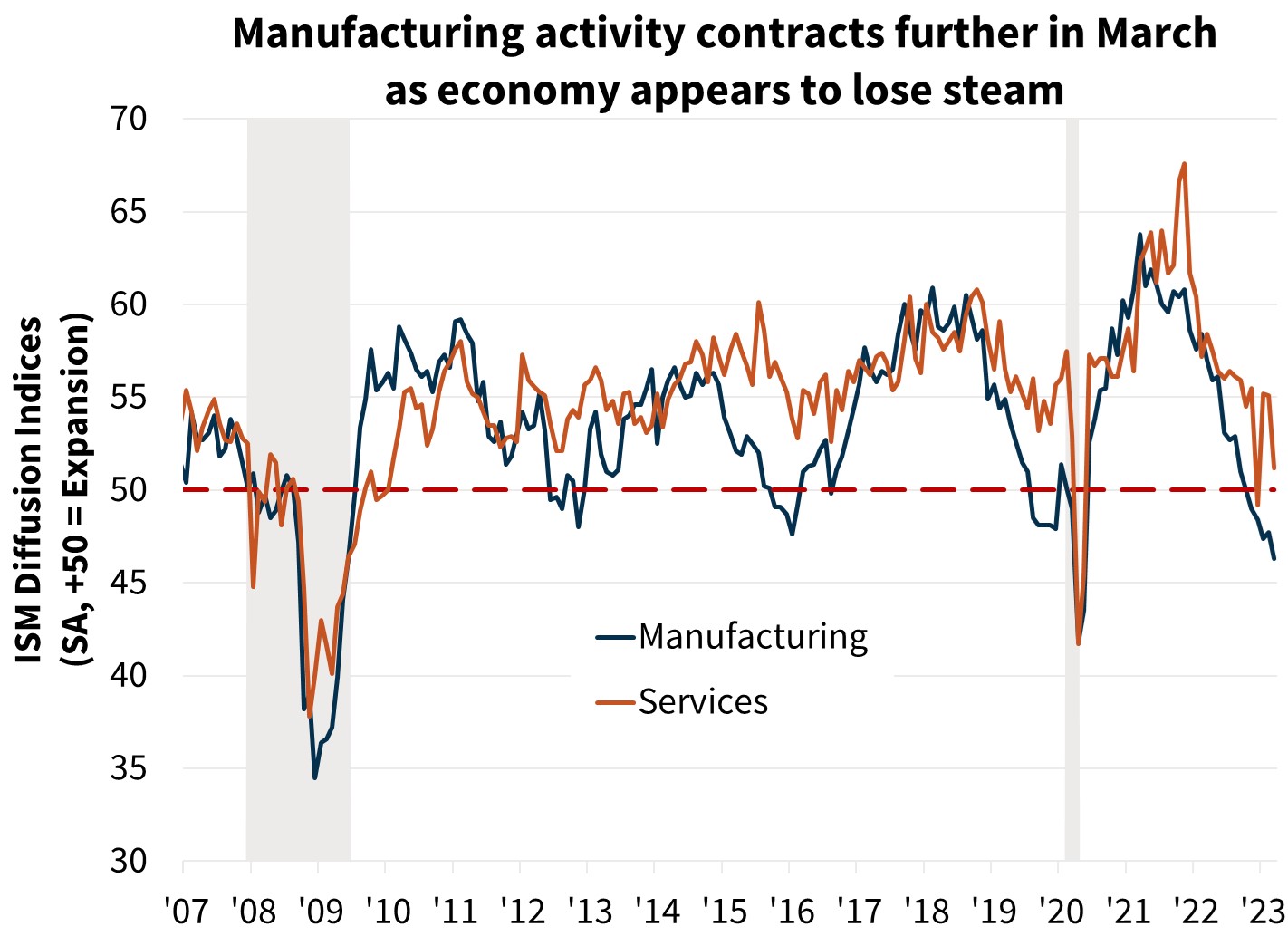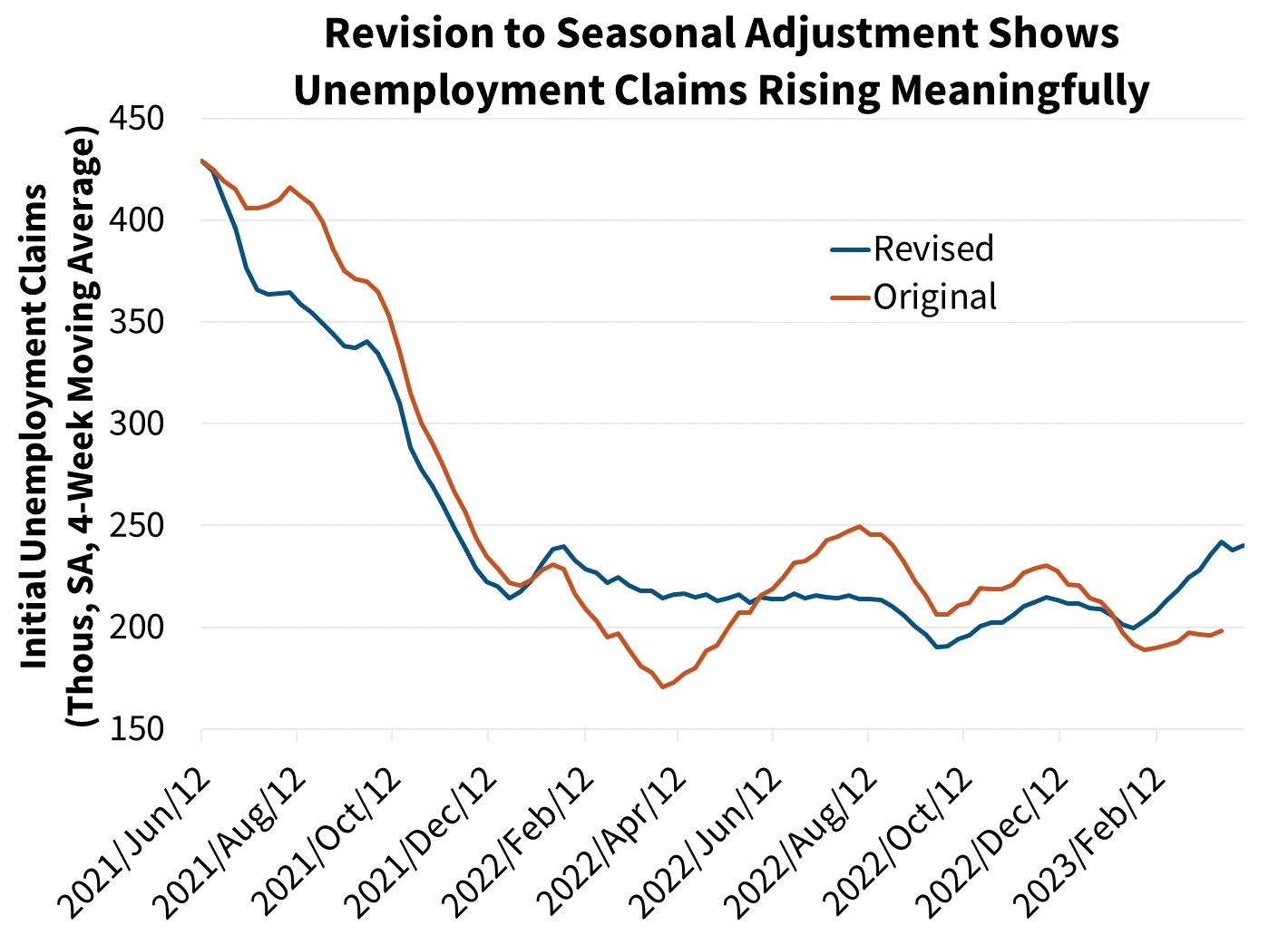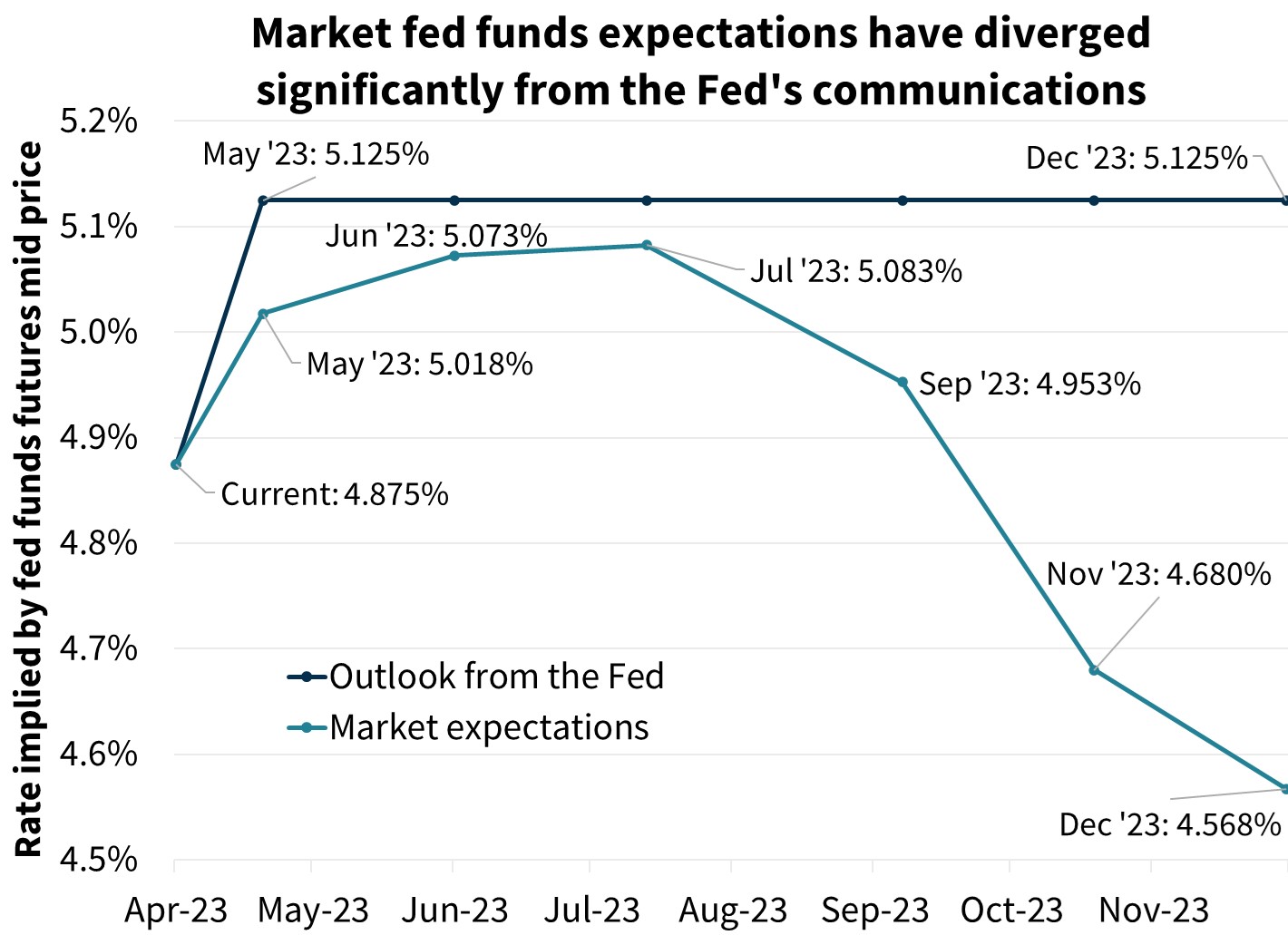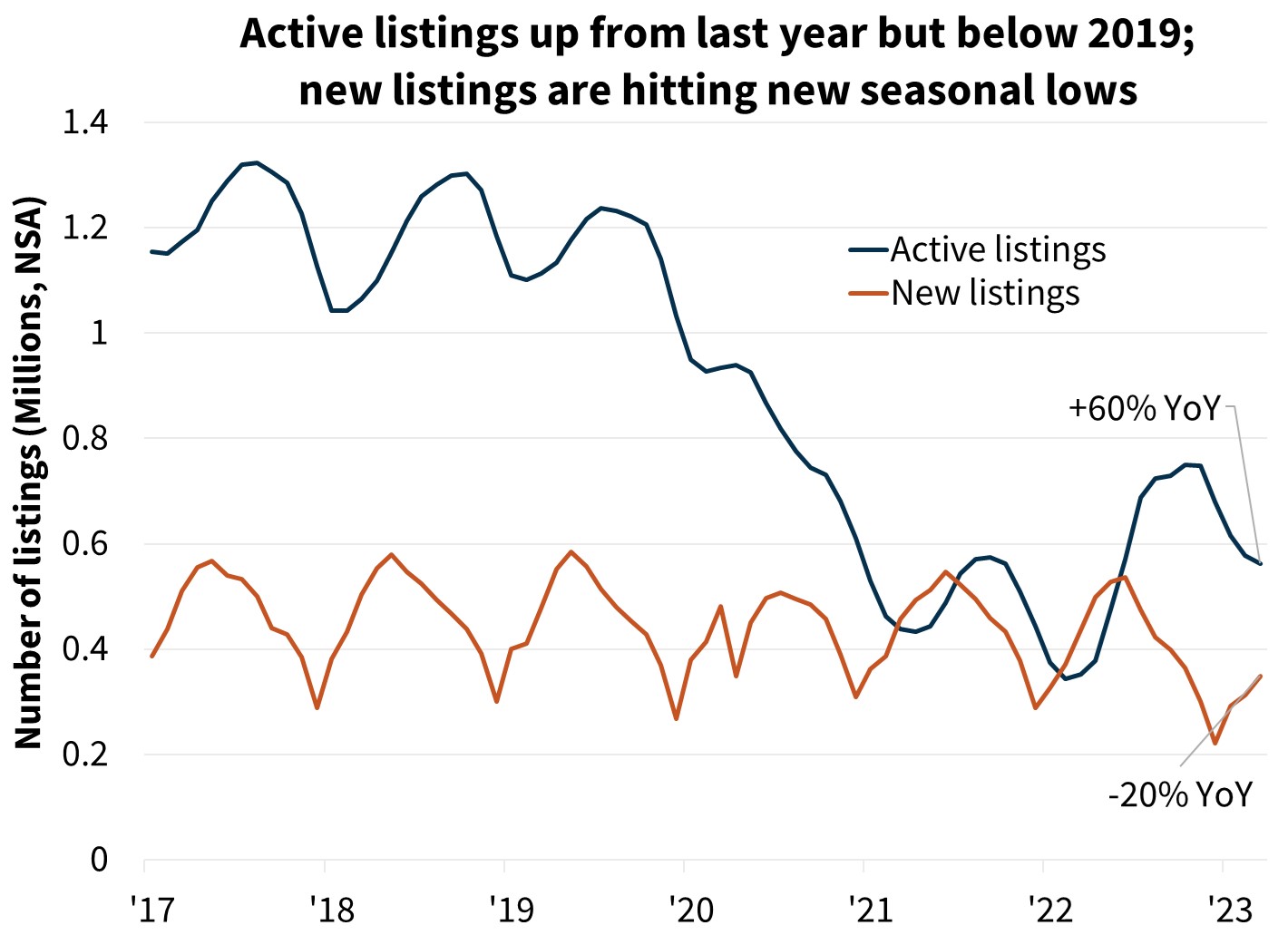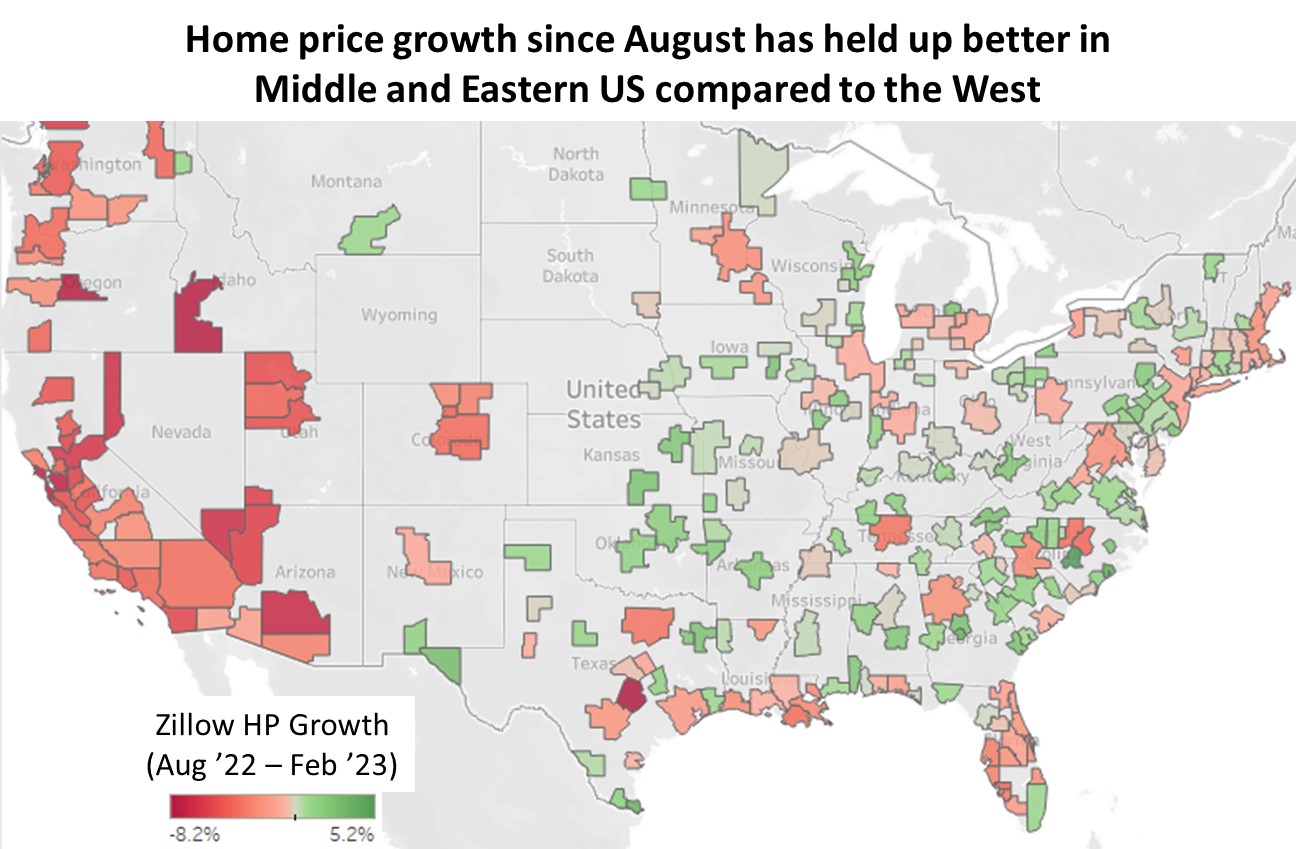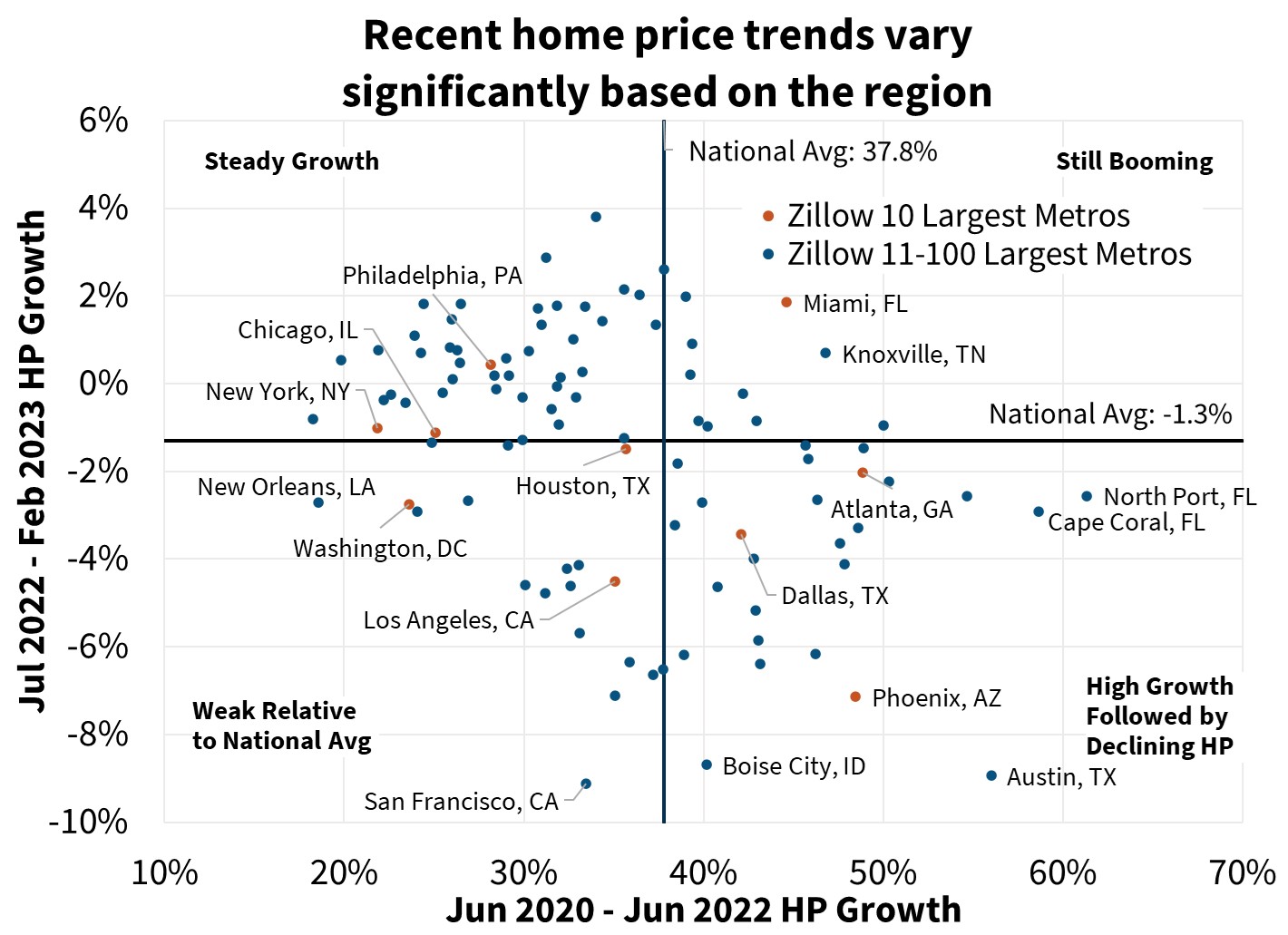The Gradual Slowdown Continues. Will Bank Turmoil Generate Tighter Credit?
The full economic effects of March’s banking turmoil have yet to be seen. The immediate, acute event appears to have passed without further escalation, but future risks remain. We continue to forecast a modest economic contraction beginning in the second half, as anticipated tighter bank lending adds to cyclical dynamics that were in place before the bank issues emerged in March. Many recent indicators, including retail sales, industrial production, and labor market data, point to an economy that decelerated meaningfully toward the end of the first quarter of 2023.
We have therefore only modestly changed our 2023 full year Real Gross Domestic Product (GDP) forecast. We now project real GDP growth on a Q4/Q4 basis to be negative 0.4 percent, down one-tenth from our prior outlook. For 2024, we have upgraded growth by 0.2-tenths to 1.4 percent. With an expectation of a modest recession beginning in the second half, we forecast the unemployment rate will move upward to 4.4 percent by year end and to rise to 5.4 percent by the end of 2024. Along with a slowing economy, we also forecast inflation will continue to decelerate, with the headline and core Consumer Price Indices (CPI) ending 2023 around 3.3 and 3.9 percent on an annual basis, respectively.
Housing activity appears to have been modestly stronger over the first quarter than previously anticipated, and with a modest pullback in mortgage rates since early March, we expect a slight pickup in sales for the spring homebuying season. We have also upgraded our quarterly house price forecast to now expect a smaller decline in house prices in 2023 on a Q4/Q4 basis. As measured by the Fannie Mae Home Price Index (FNM-HPI), we now anticipate negative 1.2 percent growth compared to our prior expectation of negative 4.2 percent growth. For 2024, we forecast prices to fall an additional 2.2 percent compared to our previous 2.3 percent projected decline. While comparatively stronger housing demand leads to more resilient prices, ongoing affordability constraints, a lack of inventory for sale, and the ongoing persistence of a “lock-in effect,” where existing homeowners with low mortgage rates are disincentivized to sell their homes, will likely keep sales subdued for the remainder of the year. While we have upwardly revised our 2023 total home sales forecast to 4.84 million units (previously 4.63 million), this still represents the slowest annual pace of sales since 2011.
With upgrades to both our home sales and home price forecasts, we have also adjusted upward our forecast for mortgage originations. We project total originations for 2023 to be $1.66 trillion, compared to our previous forecast of $1.55 trillion. For 2024, we anticipate volumes of $2.02 trillion, compared to our prior forecast of $1.89 trillion.
Economic Activity Softens from Beginning-of-Year Highs
We have moved upward our final Q1 2023 growth estimate, due primarily to a revision of January real personal consumption expenditures (PCE) data. With real PCE now reported as growing by a robust 1.5 percent in January (previously 1.1 percent), Q1 is now on track to post strong consumption growth despite a modest 0.1 percent pullback in February and a similar decline expected in March. In fact, retail sales fell 1.0 percent in March. While much of this was due to a softening in gasoline prices, the “control group” sales measure, which feeds into the GDP report, declined also, albeit by a lesser 0.3 percent. Some recent high frequency data on credit/debit card purchases suggest that there may be a rebound to start April, but given personal consumption continuing at an unsustainable pace relative to current income levels, we expect consumer spending to remain generally soft going forward.
Manufacturing activity also continues to slow. March industrial production rose 0.4 percent, but this was due to a large rebound in utility output as colder weather returned. In contrast, manufacturing output fell 0.5 percent, as did manufacturing less the volatile autos component. Combined with a further 1.4-point decline in the Institute for Supply Management (ISM) Manufacturing survey to 46.3 (below the expansionary threshold of 50), these datapoints support our view that the cyclical goods sectors of the economy continue to slow.
Meanwhile, labor market indicators have pointed to remarkable strength in recent months, even as other measures suggest weaker economic growth. Payroll employment increased by a strong 236,000 in March. While this was a deceleration from the surge over the prior two months, much of the prior jump was likely due to unseasonably warm weather to start the year. March payroll growth was similar to that of Q4 2022.
However, other labor market indicators are more clearly showing deceleration. Recent revisions to the seasonal adjustment process for both initial and continuing unemployment insurance claims now show a marked increase over the past two months compared to the original reports, a pattern that is historically consistent with a turning of the business cycle. Additionally, the Job Openings and Turnover Survey (JOLTS) showed a pullback in job openings in February, and the ISM and National Federation of Independent Businesses (NFIB) business surveys continue to point to softening in the hiring component. We are forecasting employment growth to begin to decelerate meaningfully over the next quarter or so before turning negative towards the end of the year.
Banking Worries Pass for Now
While it remains too early to tell the extent to which the banking turmoil in March will lead to tighter credit conditions and reduced business investment activity, the acute panic appears to have subsided. No additional bank failures have occurred since mid-March, and high frequency data from the Federal Reserve show that aggregate banking deposits have stabilized in the most recent weeks. This includes deposits at small banks, which were roughly flat and even rose somewhat over the past two weeks. Additionally, bank borrowings from the Fed’s discount window have pulled back for four consecutive weeks. Risk of additional banking events remains as deposit pressures continue and the credit cycle turns. Risks in commercial real estate and auto lending are of note. However, combined with little evidence of credit spreads widening, acute liquidity stress from mid-March appears to have subsided, at least for now.
Still, the bank failures and ongoing fallout occurred during a period when credit conditions were already tightening, so any additional marginal tightening may end up contributing to an eventual expected recession. Even in the absence of additional acute panics, banks needing to contend with continuing funding pressures given higher interest rates will likely be more reluctant to grow their lending portfolios. The continued pullback in longer-term interest rates relative to pre-banking turmoil (the 10-year Treasury rate as of this writing was 3.52 percent compared to 3.93 percent just prior to the Silicon Valley Bank failure) combined with a lack of accelerating inflation expectations, as measured by the TIPS spread, suggests that financial markets are still anticipating that the recent banking difficulty will drag at least modestly on economic activity. The Fed’s high frequency survey of bank lending points to at least some pullback in outstanding bank credit, especially in business loans. However, much of the decline is due to noise within the survey resulting from Silicon Valley Bank and Signature Bank failing and having their assets moved into FDIC receivership. Still, the most recent NFIB survey also showed a continued movement upward in firms reporting that credit is more difficult to acquire. We expect that a tightening in bank lending will contribute to weaker economic activity.
Tighter Credit Standards or Higher Interest Rate?
In our previous commentary we discussed how tighter bank lending conditions had the potential to be a substitute for additional fed funds rate hikes with regards to cooling demand in the economy, and therefore inflation. At the March press conference of the Federal Open Market Committee (FOMC), Chairman Powell mentioned this tradeoff, saying, “the events of the last two weeks are likely to result in some tightening credit conditions for households and businesses and thereby weigh on demand, on the labor market, and on inflation. Such a tightening in financial conditions would work in the same direction as rate tightening. In principle, as a matter of fact, you can think of it as being the equivalent of a rate hike or perhaps more.”
Given continued persistence in core inflation in recent months, we therefore expect that one way or another, there will remain an increasingly restrictive monetary policy path in the near term. It’s only a question of how many additional rate hikes occur versus how much lending conditions further tighten due to banking pressures. We anticipate that the next month or so of Fed survey data on outstanding bank loans, as well as the Q2 Senior Loan Officer Survey of bank lending standards, will shed more light on this.
Financial markets also appear to be wrestling with this question. Following the bank failures in March, a wide disconnect opened between futures market expectations for short-term interest rates and Federal Reserve guidance. While the latest Summary of Economic Projections (SEP) has the median expectation for the Federal Funds Rate at 5.1 percent at the end of 2023, futures markets at one point were anticipating 100 basis points of cuts by the end of the year. But as the acute effects of the turmoil passed in recent weeks, the gap has narrowed. Current pricing implies 50 basis points of rate cuts later this year following one final hike at the May meeting.
Our outlook includes a 25-basis point hike in May followed by a single 25-basis point cut in the fourth quarter, given our ongoing expectation for a modest recession and a significant weakening of the labor market. However, there is significant risk around this rate forecast due to the tradeoff of higher rates versus a non-Fed-led tightening in financial conditions; we expect the macroeconomic effects to be similar in either case. Although, if something closer to what the Fed is officially projecting occurs rather than our outlook, then there’s the possibility of another jump in mortgage rates. While short- and long-run rates do not necessarily move together, previous instances of the market’s predictions of an early pivot in Fed policy have coincided with meaningful increases in mortgage rates after those expectations turned out to be unfounded. This, of course, would weigh on housing activity more than our baseline forecast suggests.
Housing Demand Resilient, But Sales Still Likely to Be Subdued
Recent homebuying activity has remained more resilient than we had anticipated. Existing home sales rebounded in February, as expected, but by a larger amount than we had forecast. Meanwhile, February pending sales, which lead closings on average by about 30-45 days, ticked up 0.8 percent, suggesting the strength in existing sales will partially flow through into March. Combined with a lower mortgage rate forecast following the March banking turmoil, we’ve modestly upgraded our existing home sales outlook for the remainder of the year. Still, at 4.2 million, our 2023 existing home sales forecast represents the slowest annual pace since 2010.
According to Realtor.com, the overall supply of listings of homes for sale in at the end of March was roughly 60 percent higher than it was a year ago. However, the total amount remains at roughly half the pre-pandemic inventory level. Furthermore, the growth in available inventory over the past year has primarily been due to a slower pace of sales rather than an increased flow of new listings. New listings over the month of March were down 20 percent compared to a year prior. We believe much of this slow pace is due to the “lock-in effect,” where existing homeowners are disincentivized from moving as it would require them to give up their existing, lower mortgage rates. In March, with an average 30-year mortgage rate at 6.54 percent, according to Freddie Mac, we estimate that over 90 percent of outstanding Fannie Mae fixed-rate, 30-year mortgages as of March 31, 2023, would have at least a 1 percent rate disincentive – with over 75 percent having a disincentive over 2 percent. In short, while we anticipate the recent modest pullback in mortgage rates following the banking turmoil in March to put a little more energy into the spring homebuying season, the total volume of sales is likely to remain subdued. Beyond the lack of inventory and the lock-in effect, affordability constraints also remain.
Ongoing lack of existing homes for sale will continue to support demand for new homes, however. While we still expect new home construction to pull back later this year, consistent with our forecasted recession, and at least in part due to tighter credit availability for construction lending, new home sales should hold up comparatively well relative to existing homes. Homebuilders continue to show a willingness to offer rate buy-downs and other incentives to move their inventories. The past year’s pullback in the price of lumber and other materials also helps builders to maintain margins even with discounting, and we would expect them to continue to do so.
Home Prices Also Comparatively Resilient, Though Large Regional Variations Exist
Resilient homebuyer demand is also reflected in recent home price movement. After falling modestly in the second half of 2022, home prices rose 1.0 percent in Q1 on a seasonally adjusted basis, as measured by the FNM-HPI. Prices were up 4.7 percent on an annual basis, a deceleration from 8.6 percent in Q4 2022. While we still anticipate prices to drift modestly lower over our forecast horizon, the pace of the projected decline has been lessened compared to our last home price forecast update in January. We now forecast house prices, again as measured by the FNM-HPI, to decline by 1.2 percent in 2023 on a Q4/Q4 basis (previously a 4.2 percent decline), followed by a further decline of 2.2 percent in 2024 (previously a 2.3 percent decline).
While national-level home price movements have been modest over the past half year and expected future declines are small over our forecast horizon, regionally there is a heightened level of variation. As measured by regional Zillow House Price Indices, some metros have already experienced nearly 10 percent home price declines since the summer of 2022, while others continue to experience modest appreciation. We expect significant regional variation to continue going forward.
Many of the metro areas that experienced booms from mid-2020 to mid-2022 are now giving back some of those price gains. These metros tend to be the non-California western metros, as well as popular retirement destinations. Some of the more expensive tech-heavy areas in California have also faced home price declines this past half year despite having comparatively weak house price appreciation previously. In contrast, many regions in the East and Midwest that saw comparatively modest gains in 2020-2021 have continued to experience house price appreciation.
Regarding multifamily housing, we have also modestly upgraded our outlook for new construction given ongoing resilience; however, we still expect a large slowdown in activity later this year. Rent growth has slowed or even outright declined from a year prior based on some measures, while vacancy rates drifted upward. Furthermore, there is a record number of multifamily units currently under construction, which are scheduled to come online later this year and into 2024. Combined with tightening credit for construction lending, we are expecting a significant slowdown in starts later this year.
Mortgage Originations Upgraded
We have upgraded our forecast for single-family purchase mortgage originations this month due to upgrades to our expectations for both home prices and home sales. In particular, we now expect purchase originations to be $1.3 trillion in 2023 and $1.4 trillion in 2024, representing upgrades of $104 billion and $86 billion, respectively, from last month’s forecast.
We have also upgraded our forecast for refinances given the lower mortgage rate path this month. We now expect refinances to be $312 billion in 2023 and $584 billion in 2024, representing upgrades of $3 billion and $46 billion, respectively. We note that refinance application activity remains subdued (see the Fannie Mae Refinance Application-Level Index, or RALI), but we expect refinances to pick up later in the year as mortgage rates fall slightly.
Economic & Strategic Research (ESR) Group
April 17, 2023
For a snapshot of macroeconomic and housing data between the monthly forecasts, please read ESR’s Economic and Housing Weekly Notes.
Data sources for charts: Institute for Supply Management, Department of Labor, Federal Reserve, CME Group, Realtor.com, Zillow, Fannie Mae.
Opinions, analyses, estimates, forecasts and other views of Fannie Mae's Economic & Strategic Research (ESR) Group included in these materials should not be construed as indicating Fannie Mae's business prospects or expected results, are based on a number of assumptions, and are subject to change without notice. How this information affects Fannie Mae will depend on many factors. Although the ESR group bases its opinions, analyses, estimates, forecasts and other views on information it considers reliable, it does not guarantee that the information provided in these materials is accurate, current or suitable for any particular purpose. Changes in the assumptions or the information underlying these views could produce materially different results. The analyses, opinions, estimates, forecasts and other views published by the ESR group represent the views of that group as of the date indicated and do not necessarily represent the views of Fannie Mae or its management.
ESR Macroeconomic Forecast Team
- Doug Duncan, SVP and Chief Economist
- Mark Palim, VP and Deputy Chief Economist
- Eric Brescia, Economics Manager
- Nick Embrey, Economist
- Nathaniel Drake, Economic Analyst
- Richard Goyette, Economic Analyst
